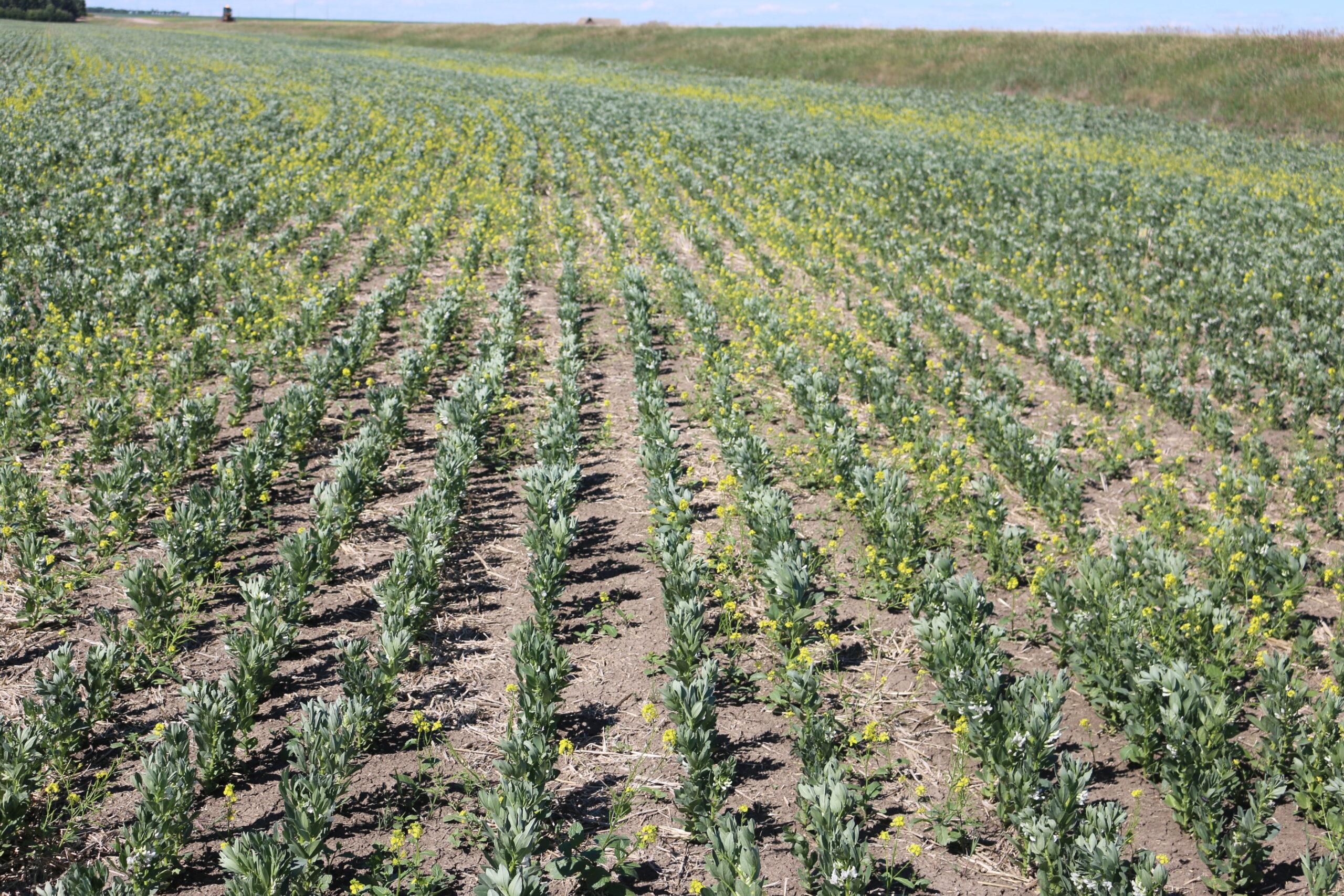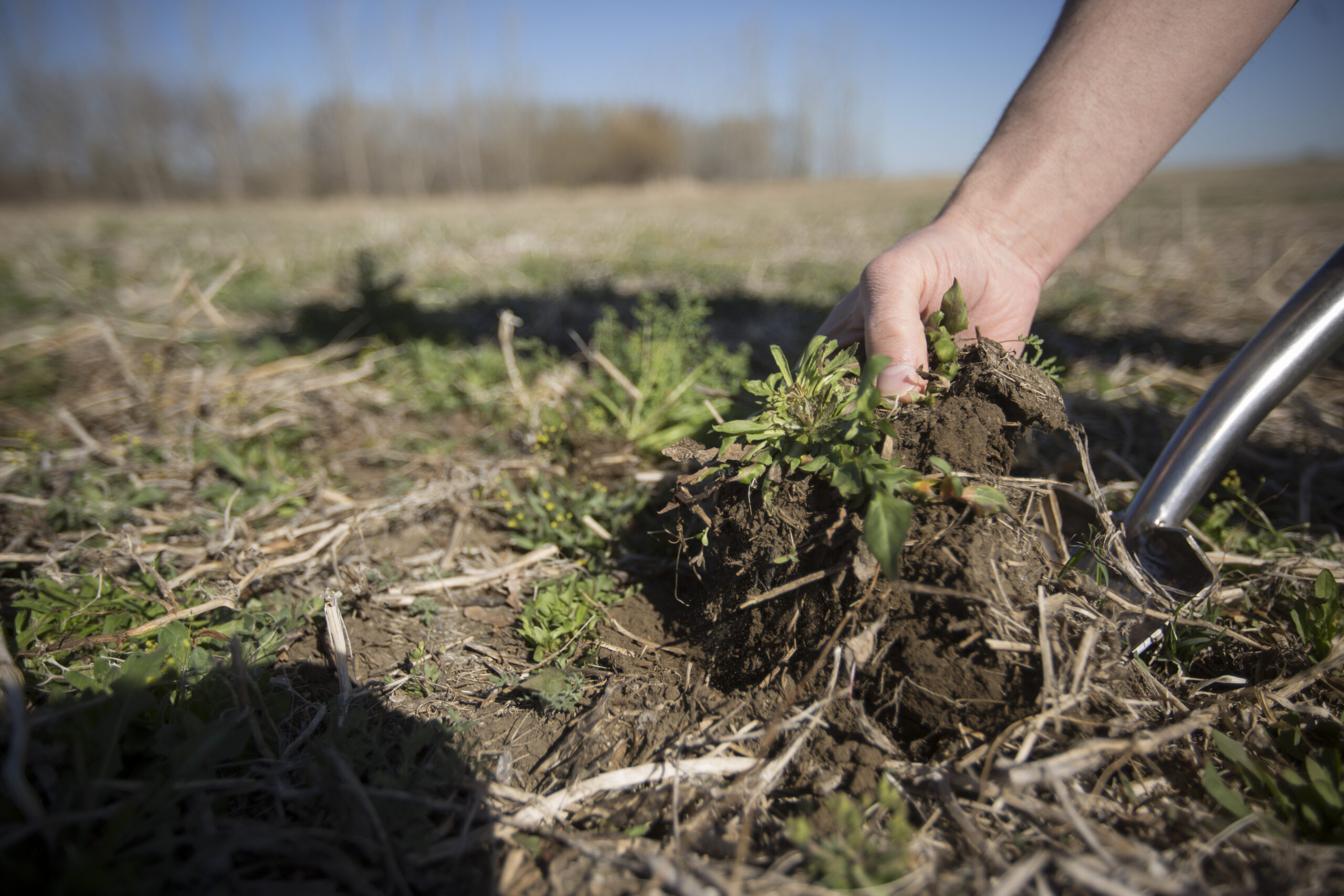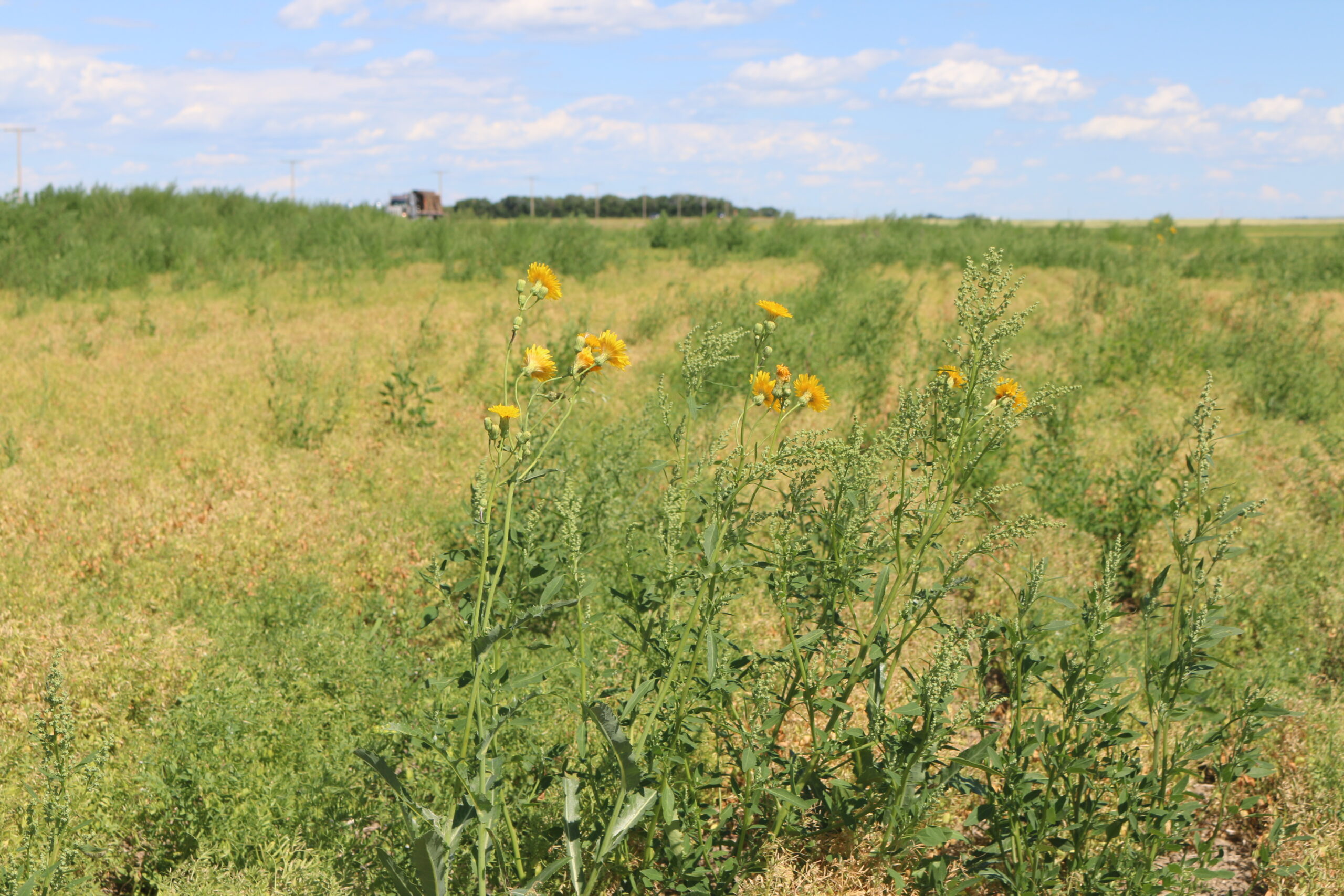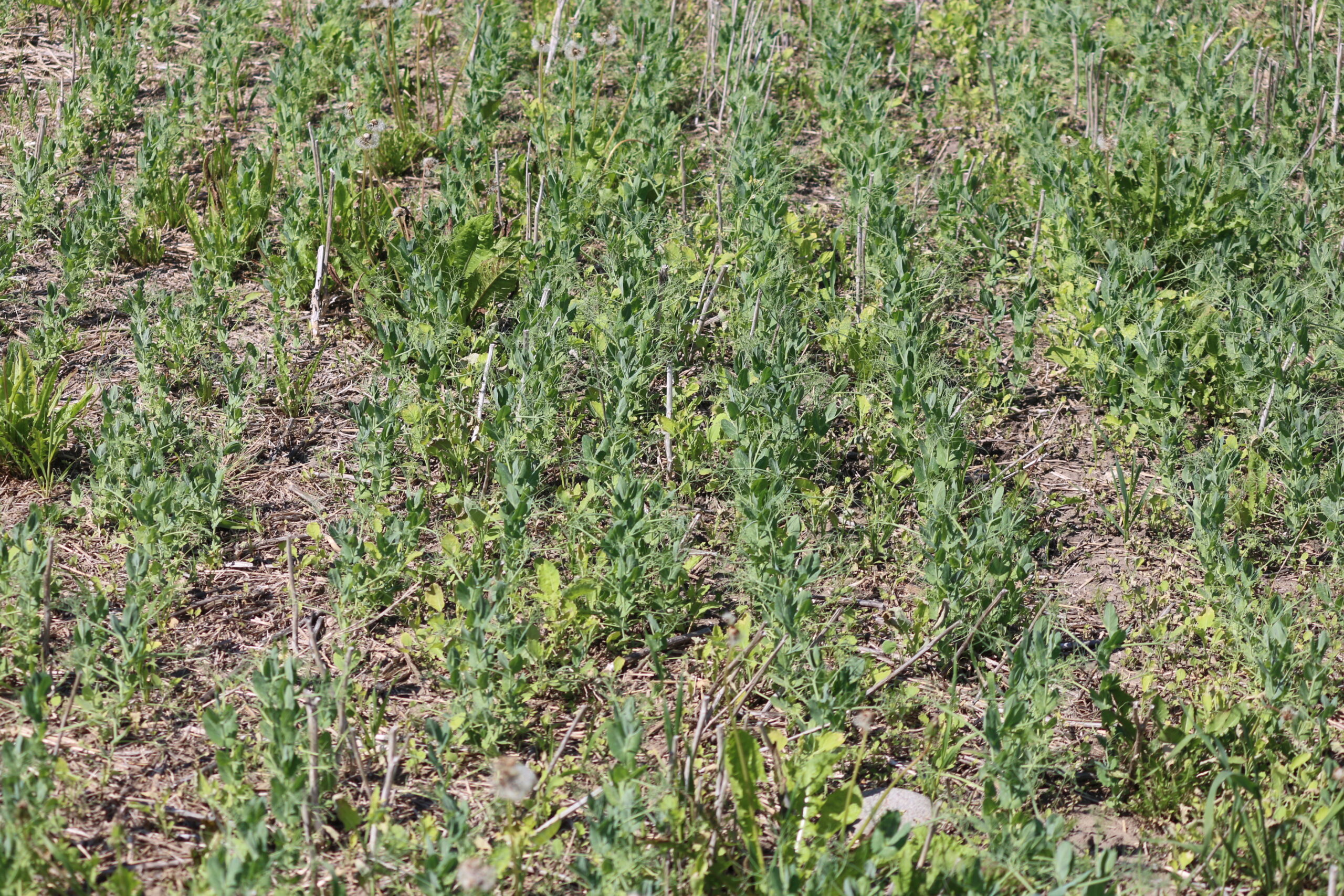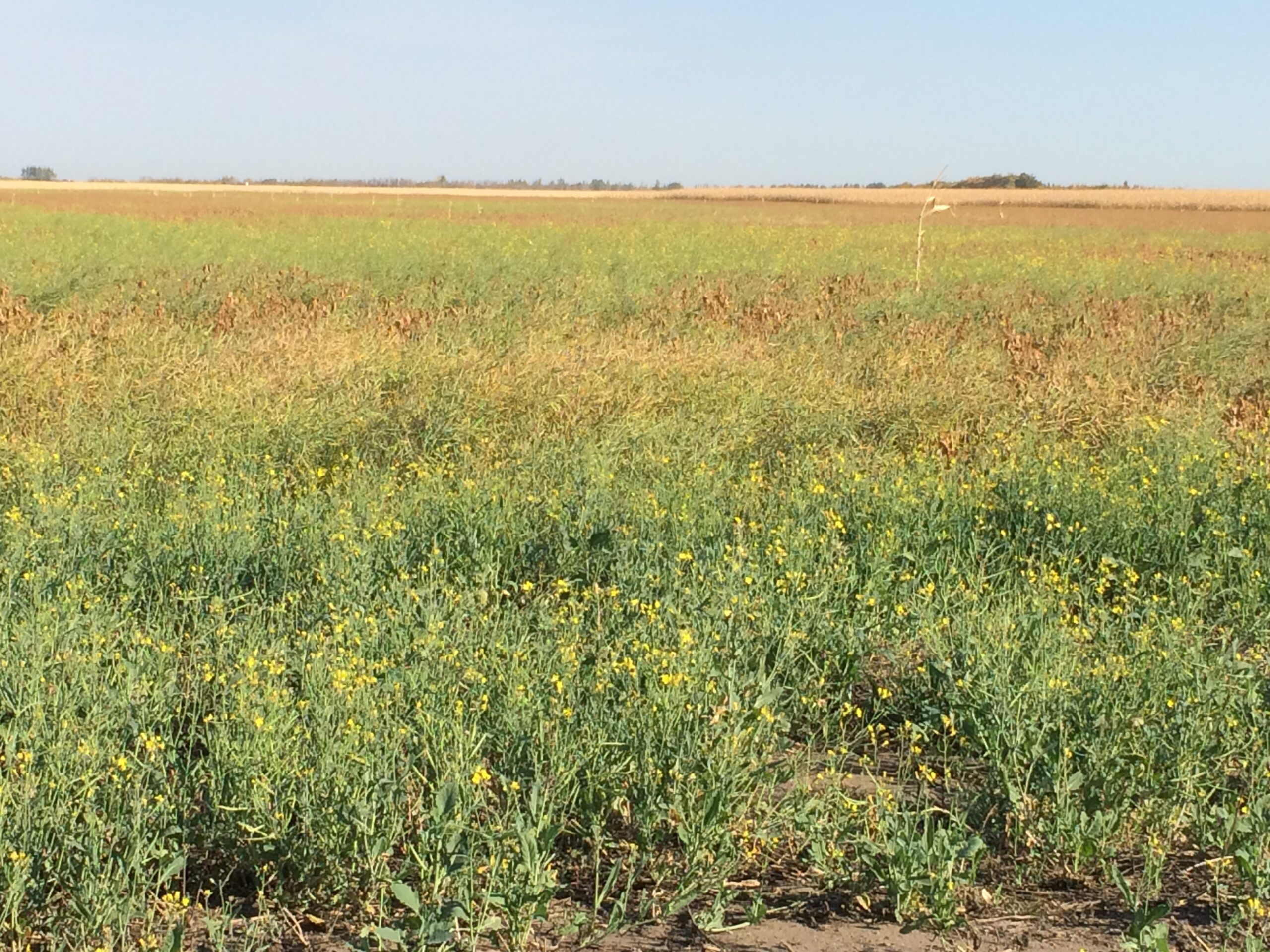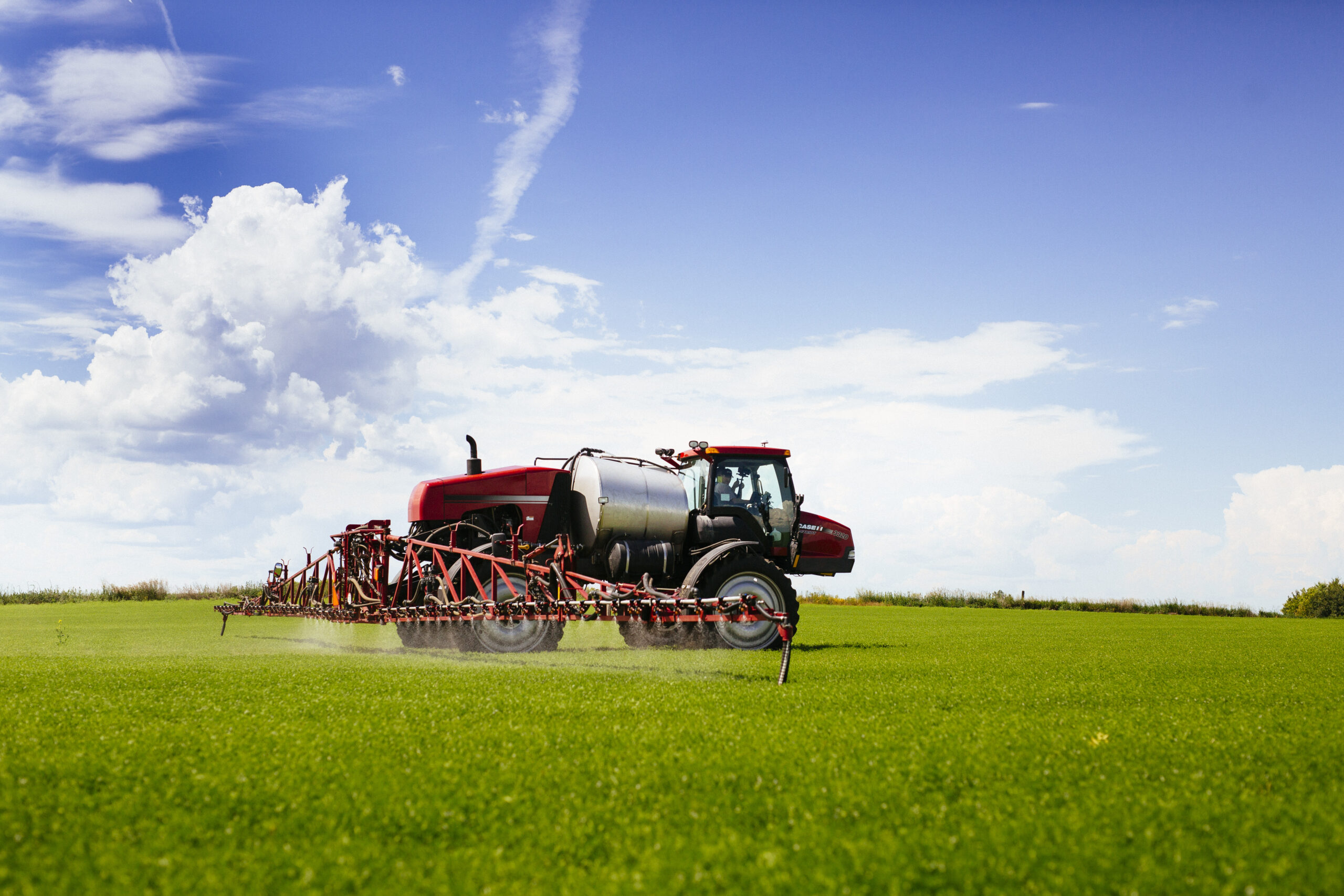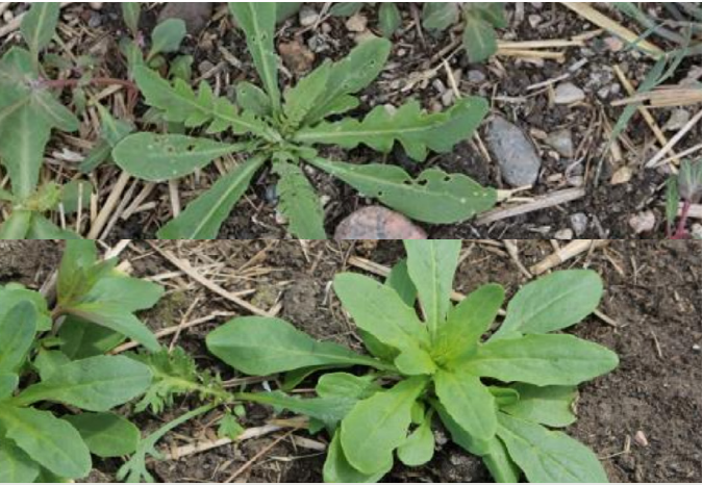Contributing Researchers: Dr. Chris Willenborg, Sid Darras, Eric Johnson, and Dr. Dilshan Benaragama
Introduction
Faba beans are a small acre crop with great economic and agronomic potential. On top of high nitrogen-fixing rates resulting in a high protein commodity, faba beans also have partial resistance to Aphanomyces root rot. As such, faba beans are a great option in the black and grey soil zones where farmers have previously taken peas or lentils out of their rotation due to extensive Aphanomyces infection. As a relatively new and low acreage pulse crop, further weed science research is needed to develop effective faba bean weed management practices. To meet this research need, Saskatchewan Pulse Growers (SPG) funded 13 faba bean weed science studies between 2016–2021 to build more robust faba bean weed management recommendations. Study areas included weed management timing, integrated weed management practices, herbicide re-cropping restrictions, new herbicide screening, and crop desiccation. Summarized below are the research results from these studies as well as the resulting best practice recommendations.
Study Area 1: Faba bean weed management timing
Controlling weeds at optimal timing will minimize yield loss from weed competition. This optimal crop growth stage is known as the critical period of weed control (CPWC) and is developed through establishing how long weeds can grow alongside the crop before yield loss is incurred, and the minimum amount of time that the crop must remain weed free to prevent yield loss. The CPWC varies by crop, and when understood, can help growers maximize spraying efficiency across multiple crops during herbicide application season.
Development of the Critical Period of Weed Control for Faba Beans
There is no established CPWC for faba beans in Western Canada, thus this research was foundational for building best practices for weed management. To develop the CPWC in faba beans, a study took place in 2018, 2019, and 2021 at Kernen and Scott Research Farms. There were 14 different treatments in which weed removal commenced or ceased at varying timings throughout the growing season (emergence, 5 node, 7 node, 9 node, start of flower, later flower/early pod). Weed and crop biomass and yield results were used to calculate the CPWC using statistical modelling.
Results showed that the faba bean CPWC varied by site and year (Figure 1). The CPWC at Kernen was from the 7–9 node stage in 2018 and the 4–6 node stage in 2021. Scott showed a CPWC from the 5–9 node stage in 2018 and the 9 node to early flower stage in 2021. Differences in CPWC were largely a result of the timing of weed emergence based on soil moisture. It was determined that the CPWC in faba bean ranges between the 4 node and 9 node stage. However, it is important to note that application windows for common in-crop faba bean herbicides (Viper® or Odyssey®) only allow applications to the 8 node stage, also referred to as the 6 leaf or 6 above ground node stage. In faba beans, nodes and true leaves do not correspond directly for example the 3rd node equates to the 1st true leaf; the 5th node corresponds to the 3rd true leaf and the 8th node corresponds with the 6th true leaf. Therefore, the CPWC identified in faba beans (4-9 node stage) correlates to the 2 to 7 leaf stage in reference to registered herbicide labels. Applying herbicides as early as possible is still recommended, but the crop must be kept weed free until the 9-leaf stage (11th node) to maximize yield.

Use of Pre-Emergent Herbicides to Extend/Broaden In-Crop Herbicide Application Window
Herbicide layering through use of a pre-emergent herbicide followed by an in-crop post-emergent herbicide can be used to delay the development of herbicide resistance. To determine whether pre- emergent herbicides can extend the in-crop herbicide application window for faba beans, three different pre-emergent herbicides with varying residual lengths, carfentrazone (Aim®, no residual), saflufenacil (Heat® LQ, short-term residual), and flumioxazin (ValteraTM, long-term residual) were compared, either with no in-crop (PRE), or Odyssey® or Viper® at either the 4 or 8 node stage (PRE+POST) (Table 1). Note that the 4 and 8 node stages are equivalent to the 2 and 6 true leaves or above ground node stages. An untreated check that received no herbicide treatment was also compared. The trial took place at Kernen and Melfort, Sask. in 2017, 2018, and 2020.
Table 1. PRE and POST herbicide treatment combinations for faba beans to determine impact of PRE herbicides on extending POST herbicide applications window
| Treatment No. | PRE Herbicide | POST Herbicide | PRE Rate g ai/ha | POST Rate g ai/ha | POST Timing |
|---|---|---|---|---|---|
| 1 | Aim® | None | 18 | 0 | |
| 2 | Aim® | Odyssey® | 18 | 30 | 4 node |
| 3 | Aim® | Viper® | 18 | 449 | 4 node |
| 4 | Aim® | None | 18 | 30 | 8 node |
| 5 | Aim® | Odyssey® | 18 | 449 | 8 node |
| 6 | Heat® LQ | Viper® | 36 | 0 | |
| 7 | Heat® LQ | None | 36 | 30 | 4 node |
| 8 | Heat® LQ | Odyssey® | 36 | 449 | 4 node |
| 9 | Heat® LQ | Viper® | 36 | 30 | 8 node |
| 10 | Heat® LQ | None | 36 | 449 | 8 node |
| 11 | Valtera™ | Odyssey® | 107 | 0 | |
| 12 | Valtera™ | Viper® | 107 | 30 | 4 node |
| 13 | Valtera™ | None | 107 | 449 | 4 node |
| 14 | Valtera™ | Odyssey® | 107 | 30 | 8 node |
| 15 | Valtera™ | Viper® | 107 | 449 | 8 node |
| 16 | Untreated | Untreated |
There was no difference in weed biomass or any other parameters between the 4 and 8 node in-crop timing. The herbicide treatments significantly impacted crop biomass, however. Faba bean biomass was higher with the PRE+POST treatments than the untreated check. Contrarily, there was no difference in crop biomass between the PRE treatments and the check. The increased crop biomass in the PRE+POST treatments did not translate to higher yield as there was no statistical difference in yield between any treatments. Weed biomass was higher in the PRE than the PRE+POST treatment, both of which were lower than the untreated check. Heat® and Valtera™ were lower in weed biomass than Aim®, which provides no residual weed control. These results indicate that even with no yield benefit, a residual pre-emergent followed by a post-emergent herbicide is still beneficial for reducing weed density and biomass and consequently reducing herbicide resistance selection pressure.
Study Area 2: Integrated weed management in faba beans
Integrated Weed Management (IWM) incorporates the use of cultural, mechanical, and chemical weed management practices to reduce herbicide selection pressure and prevent the development of resistant weeds. Cultural weed control methods include narrow row spacing, increased seeding rate, use of cover crops, or weed seed destruction. Mechanical weed control includes tillage, mowing, or hoeing. Some of the above cultural and mechanical methods were studied in conjunction with chemical herbicide application to develop IWM strategies for faba beans.
Interaction of Seeding Rate and Pre-Emergent Herbicides
One of the IWM studies involved combining increased faba bean seeding rate with pre-emergent herbicide application to determine if in-crop weed pressure, and subsequent herbicide selection pressure, could be reduced. Seeding rates compared included 10, 25, 50, 75, 100, 125, and 150 seeds per square metre (m2), which translates roughly to 2.5, 5, 7.5, 10, 12.5, and 15 plants per square foot (ft2). The recommended target plant stand for faba beans is 44 plants/m2 (approximately 4 plants/ft2). Herbicides compared were glyphosate alone, glyphosate with Authority® Supreme (PRE), and glyphosate with Authority® Supreme followed by Viper® ADV post-emergent (PRE+POST). Research took place at Kernen, Sask. from 2017 to 2019, and in Melfort, Sask. in 2019.
Seeding rate and herbicide did not interact to impact weed biomass. Weed biomass was impacted by herbicide at three of four site-years (Figure 2). At two of four site-years, the PRE treatment reduced weed biomass from 65–85% compared to the glyphosate only treatment (Kernen 2017 and 2018). Also, in two of four site-years, the PRE+POST treatment further reduced weed biomass compared to the PRE treatment by 85–98% (Kernen 2018 and 2019).
Contrary to weed biomass, weed seed production was impacted by the interaction of herbicide treatment and seeding rate in three of four site-years. In 2017 at Kernen, weed seed production did not change with seeding rate with either the PRE or PRE+POST treatment. With glyphosate alone, however, weed seed production decreased by 40% as seeding rate increased. At Kernen in 2019, weed seed production was much higher for the glyphosate only and PRE treatments, but decreased with increased seeding rate. Weed seed production was lower overall at Melfort in 2019 and decreased with increased seeding rate. These results indicate that an increased seeding rate has potential to reduce weed seed production, especially when a post- emergent herbicide is not applied. If pre-emergent glyphosate is the only herbicide, a seeding rate of 125 seeds/m2 is recommended.
Faba bean yield response to increased seeding rate differed between herbicide treatments. The PRE+POST treatment had a higher maximum yield at all seeding rates than the PRE or glyphosate only treatments. The PRE treatment was 29% higher yielding than the glyphosate only treatment, and the PRE+POST treatment was 19% higher yielding than the PRE treatment.
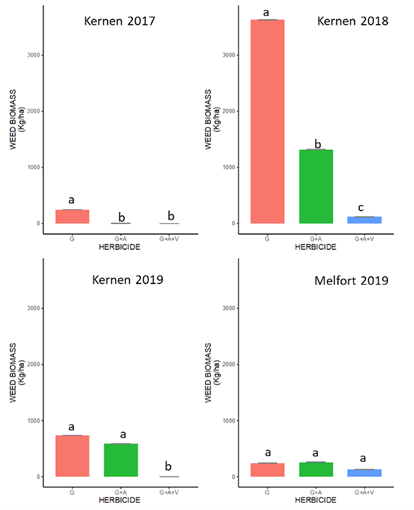
Increased seeding rate improved weed competition of faba beans as well as overall crop productivity, thus seeding rates above 50 seeds/ m2 are recommended. Addition of a pre-emergent residual herbicide such as Authority® Supreme improved yield over glyphosate only, and yield was further improved by the addition of an in-crop herbicide such as Viper®. Where only glyphosate is going to be applied, seeding rates of up to 125 seed/m2 should be used, however, some yield will likely be forfeited by not using a pre-emergent or in-crop herbicide.
Interaction of IWM Management Intensity and Pre-Emergent Herbicides
Along with increased seeding rate and use of pre-emergent herbicides, manipulating seeding date and row spacing, and using mechanical weed control are additional IWM practices to combat weed resistance development. A study took place from 2017 to 2019 at Kernen Research Farm looking at high, medium, and low levels of IWM integration. The high-level integration treatment included early seeding (May 5–10), narrow (30 cm) row spacing, high seeding rate of 95 seeds/m2 (9.5 plants/ft2), and mechanical rotary hoeing. The medium integration level involved an average seeding date (May 18–24), narrow row spacing, regular seeding rate of 45 seeds/m2 (4.5 plants/ft2), and no rotary hoeing. The low integration level was comprised of late seeding (May 30 to June 7), wide row spacing of 60 cm, regular seeding rate of 45 seeds/m2 (4.5 plants/ft2), and no mechanical control.
Along with the integration level treatments, the study compared four levels of pre-emergent herbicides: no residual, shorter residual (saflufenacil, Heat®, 50 g active ingredient (ai) per hectare (ha) (30 acre (ac) per case (cs)) rate), moderate residual (flumioxazin, ValteraTM, 150 g ai/ha), and longer residual (pyroxasulfone and sulfentrazone, Authority® Supreme, 250 g ai/ha). Each pre-emergent herbicide treatment was layered over the integration level treatments.
Weed biomass, weed seed production, and crop yield were assessed. Results showed that compared to glyphosate alone, Heat® and Authority® Supreme reduced weed biomass by 70 to 90% depending on site-year (Figure 3). Valtera™ also reduced weed biomass, but to a lesser degree than the other two pre-emergent herbicides at three of four site-years. The pre-emergent herbicides reduced weed seed production similarly by 50–70% compared to glyphosate alone. The medium and high integration level treatments had 70–90% lower weed biomass than the low level at three of four site-years (Figure 4). As well, in two of four site-years, the high intensity IWM treatment had significantly lower weed biomass than the medium intensity IWM treatment. Weed seed production results followed the same trend as weed biomass, with a 60–90% drop in weed seed yield from the low to high IWM intensity treatment at three of four site-years. There was a significant difference between the medium and high IWM treatment at only one of four site-years.
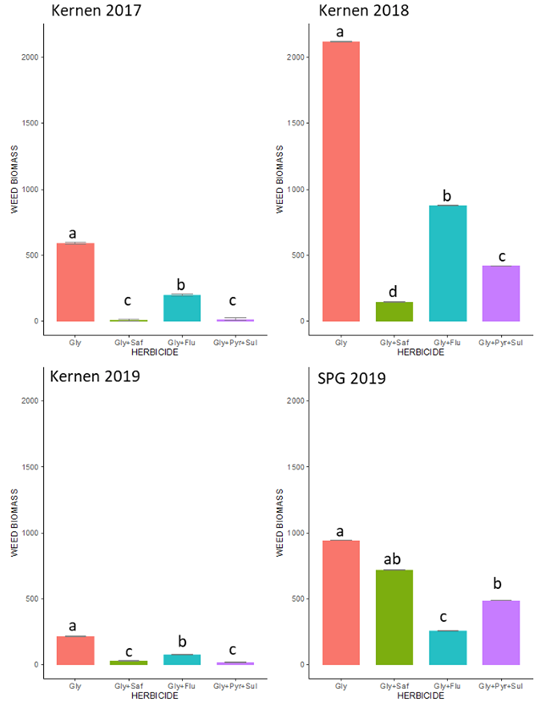
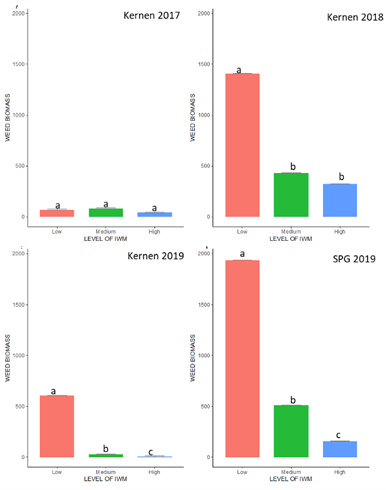
Crop yield was lowest in the low intensity IWM treatment at all four site-years by anywhere from 52–426% compared to the high intensity treatment (Figure 5). The difference in yield between the low and medium IWM intensity treatments was greater than the difference in yield between the medium and high IWM intensity treatments at most site-years. Yield in the high IWM intensity treatments was -17% to +27% compared to the medium IWM intensity treatment, whereas the medium IWM intensity treatment was 57–314% higher than the low IWM intensity treatment. The high intensity IWM treatment was higher yielding than the medium IWM treatment at two of four site-years, indicating opportunity for yield increase with high IWM integration over the medium 50% of the time.
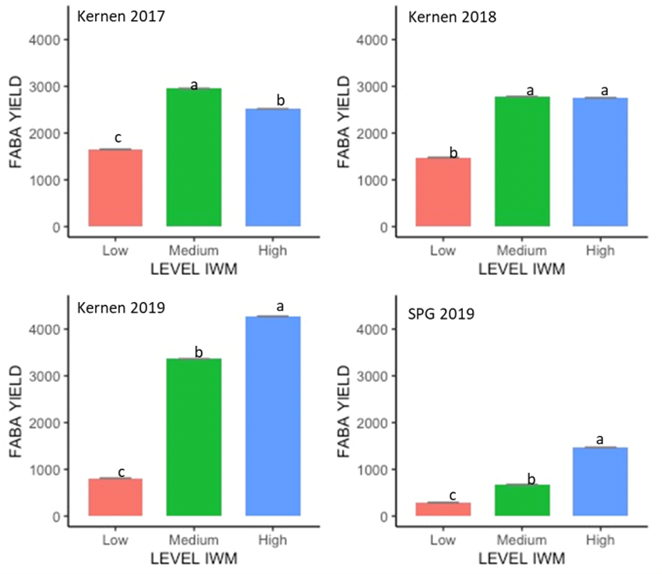
Both increasing the intensity of the IWM program and using pre- emergent residual herbicides with glyphosate improved weed management and crop yield in faba beans. Authority Supreme® and Heat® reduced weed biomass compared to glyphosate alone more than Valtera™, however all three products resulted in similar decreases in weed seed production. Regarding the IWM treatments, yield improvement from the low to medium intensity IWM treatment was larger than the improvement from the medium to high IWM intensity treatment. These results indicate that growers are likely to see improvements in yield and weed control from adoption of relatively simple cultural practices such as early seeding and reduced row spacing, along with residual pre-emergent herbicide use.
Study Area 3: Herbicide recropping restrictions ahead of faba beans
As faba beans are a smaller acreage crop, they are not usually included amongst crops tested for herbicide re-cropping restrictions. The following three studies will look at phytotoxic and yield impacts of residual from herbicides commonly applied in the previous year to develop better re-cropping recommendations for faba beans.
Re-Cropping of Faba Beans After Herbicides With Residual Carryover
To develop re-cropping restrictions for faba beans, this study assessed the phytotoxic impact of growing faba beans on soils treated with several common residual in-crop herbicides applied in the previous year. From 2017–2019, at Kernen, Scott, and Melfort, Sask., for a total of seven site-years, faba beans were grown on wheat stubble treated with seven herbicides at multiple rates summarized in Table 2. Crop density, crop injury, and yield were assessed to determine the impact of the previous year herbicide. Crop injury was observed at 11, 25, 54, and 89 days after emergence (DAE).
Table 2. Residual herbicide treatments applied in the previous cropping year
| Herbicide | Trade Name | Rate g ai/ha | Rate level |
|---|---|---|---|
| Clopyralid | Lontrel™ | 100 | Low rate |
| 200 | High rate | ||
| 400 | 2x high rate | ||
| Quinclorac | Facet L® or Accord® | 50 | Low rate |
| 100 | High rate | ||
| 200 | 2x high rate | ||
| Flucarbazone-sodium | Everest® | 20 | 100 ac/jug rate |
| 40 | 50 ac/jug rate (off label) | ||
| 60 | 2x high (67ac) rate | ||
| Pyrasulfatole + bromoxynil | Infinity® | 200 | 1x rate |
| 400 | 2x rate | ||
| Dicamba | Banvel® II | 300 | |
| 600 | |||
| 1200 | |||
| Metsulfuron-methyl | Ally® | 4.5 | 1x rate |
| 9 | 2x rate | ||
| Post-harvest 2,4-D | 2,4-D | 420 | 6 oz/ac rate |
| 840 | 12 oz/ac rate |
No herbicide treatment consistently resulted in faba bean crop injury or yield reduction across the seven site-years (Table 3). Under the right conditions, such as dry soil moisture, low pH, and low soil organic matter (SOM) conditions, most herbicides produced visual injury symptoms. Across all site-years, quinclorac (Accord®) and clopyralid (Lontrel®) had the greatest reductions in crop density and yield, as well as the highest crop injury. In 2018, Lontrel® at the highest rates reduced yield by 53% and 54% at Kernen and Scott respectively. At Scott in 2018, Accord® caused yield reductions of 41 and 80% at the 100 and 200 g ai/ha rates respectively. No other herbicides caused significant yield reductions at any rate. Any crop density reductions or crop injury from other actives did not translate to yield loss. From these results, growers should avoid seeding faba beans where quinclorac and clopyralid have been used in the previous cropping year.
Table 3. Herbicide phytotoxicity and yield impact from residual herbicide treatments across seven site-years
| Herbicide | Trade Name | Rate g ai/ha | Type of Injury |
|---|---|---|---|
| Clopyralid | Lontrel™ | 100 | – |
| 200 | Scott 2018: 20% crop injury | ||
| 400 | Kernen 2018: 53% yield reduction Scott 2018: 38% injury, 4-day delay to flower, 54% yield reduction | ||
| Quinclorac | Accord® | 50 | Kernen 2017: 22% crop density reduction Scott 2017: 40% crop injury |
| 100 | Kernen 2017: 8% crop density reduction Scott 2017: 68% crop injury, 65% yield reduction Scott 2018: 41% yield reduction | ||
| 200 | Kernen 2017: 16% crop density reduction Scott 2017: 38% crop injury, 60% yield reduction Kernen 2018: non-significant yield reduction trend Scott 2018: 80% yield reduction | ||
| Flucarbazone-sodium | Everest® | 20 | – |
| 40 | Kernen 2017: 10% crop injury | ||
| 60 | Kernen 2018: non-significant yield reduction trend | ||
| Pyrasulfatole + bromoxynil | Infinity® | 200 | – |
| 400 | Kernen 2017: 20% crop density reduction | ||
| Dicamba | Banvel® II | 300 | – |
| 600 | – | ||
| 1200 | Kernen 2018: season long crop injury | ||
| Metsulfuron-methyl | Ally® | 4.5 | – |
| 9 | Kernen 2017: 20% crop density reduction Kernen 2018: non-significant yield reduction trend | ||
| Post-harvest 2,4-D | 2,4-D | 420 | – |
| 840 | – |
Tolerance of Differing Faba Bean Cultivars to Herbicide Residues
As an extension of the above study, several faba bean varieties were grown on a subset of residual carryover herbicides at higher rates to determine if certain varieties have greater resistance to herbicide carryover damage. The faba bean cultivars tested included three low- tannin varieties: CDC Snowdrop, Snowbird, and Tabasco, and three tannin varieties: CDC SSNS-1, Malik, and Taboar. Each variety was grown in 2017 and 2018 on soil treated the previous fall (2016 and 2017 respectively) with Lontrel™ (300 g ai/ha), Accord® (200 g ai/ ha), Everest® (40 g ai/ha), and Ally® (9 g ai/ha).
Results showed that there was no difference in crop establishment, biomass, or yield between faba bean varieties for any of the herbicide residues assessed. Lontrel™ produced the highest crop biomass and yield reductions in 2017 and therefore, was not assessed in 2018 (Table 4). In 2018, there was no significant biomass or yield reductions among herbicides, but Everest® had higher visual crop injury than the other treatments and was lowest yielding amongst the treatments.
Table 4. Impact of herbicide treatments on crop biomass and yield compared to untreated check for 2018 and 2019
| Herbicide Trade Name | Rate g ai/ha | Year | Crop Biomass Reduction | Yield Reduction |
|---|---|---|---|---|
| Lontrel™ | 300 | 2017 | 90% | 82% |
| 2018 | N/A | N/A | ||
| Everest® | 40 | 2017 | 54% | 39% |
| 2018 | – | – | ||
| Ally® | 9 | 2017 | 75% | 52% |
| 2018 | – | – | ||
| Accord® | 200 | 2017 | 31% | – |
| 2018 | – | – |
Much more research has been done to develop re-cropping restrictions for field peas than faba beans. This study compared the response of field peas and faba beans grown where group 2 and 4 herbicides had been applied to the soil the previous fall to determine if well-established field pea re-cropping recommendations can be extended to faba beans. CDC Snowdrop faba beans and CDC Meadow field peas were grown on flucarbazone-sodium (Everest®) and clopyralid (Lontrel™) residue with a dose response rate structure. Everest® rates were 0, 3.75, 7.5, 15, 30, 60, 120 and 240 g ai/ha and Lontrel™ rates were 0, 18.75, 37.5, 75, 150, 300, 600, and 1200 g ai/ha applied in the fall of 2016. From these rates, an ED50 was determined. ED50 is the rate that produces a 50% decrease in the parameter of interest and roughly corresponds to a 50% reduction in weed biomass. A lower ED50 indicates greater sensitivity. The ED50 was calculated from crop establishment, biomass, and yield assessments.
Like the above studies, crop injury and yield loss in faba beans was much higher with Lontrel™ than Everest®. Responses to Everest® were similar between faba beans and peas. Everest® did not impact crop density for either crop. The ED50 of Everest® for crop biomass was 158 and 124 g ai/ha for field pea and faba bean respectively. The ED50 for yield loss with Everest® was 202 and 200 g ai/ha for field pea and faba bean respectively. Contrary to Everest®, faba bean was much more sensitive to Lontrel™ than field pea. The ED50 of Lontrel™ for crop density was 430 g ai/ha for field peas and 257 g ai/ha for faba beans. The ED50 of Lontrel™ for biomass was 434 and 185 g ai/ha for field peas and faba beans respectively, and the ED50 for yield was 415 and 269 g ai/ha for field peas and faba beans respectively. Dose responses to Everest® residue were similar for faba beans and field peas, however, faba beans were more sensitive to Lontrel™ residue. As such, faba bean re-cropping for Everest is expected to be similar to peas, however, re-cropping of faba beans after Lontrel™ should be more restrictive than peas because of greater sensitivity.
Study Area 4: New herbicide screening
Several herbicides exist for pulse crops that may be safe for use on faba beans, however, research has not been completed up to this point. Research into suitability of pre-emergent residual and post- emergent in-crop herbicides was completed to expand the list of potential faba weed control options. As well, pre-emergent herbicides alone, in-crop herbicides alone, or the layering of pre- and post- emergent herbicides were compared, assessing weed control and faba yield to develop crop safe, effective recommendations.
Tolerance of Faba Beans to Pre-Emergent Herbicides
Several pre-emergent residual herbicides that are registered on other pulse crops do not have registration on faba beans. This study therefore assessed seven such pre-emergent residual herbicides for their suitability ahead of faba beans. Products were applied at the 1x and 2x rates (1x rates listed) and included sulfentrazone (140 g ai ha-1, Authority®), pyroxasulfone plus carfentrazone (125 and 9 g ai ha-1 respectively, Focus®), pyroxasulfone plus sulfentrazone (125 and 125 g ai haha-1 respectively, Authority® Supreme), pyroxasulfone plus saflufenacil (125 and 36 g ai haha-1 respectively, Zidua® and Heat®), flumioxazin (70 g ai haha-1, Valtera™), pyroxasulfone plus flumioxazin (125 and 70 g ai haha-1 respectively, Fierce®), and saflufenacil (50 g ai haha-1, Heat®). Only Authority® and Heat® are registered for faba beans as of 2022. Products were applied 4 to 6 days after seeding. The trial took place at Kernen and Goodale research farms in the 2018, 2019, and 2020 growing seasons. Plant density, phytotoxic symptoms, plant height, and yield were assessed.
In general, most pre-emergent herbicides had no impact on crop establishment, development, or yield compared to the check, however, there was a small amount of damage to note. At Goodale in 2018, visual plant ratings 12 days after emergence (DAE) showed unacceptable injury (>10%) in the Zidua® plus Heat® and Fierce® treatments at both rates, and in the 2x Valtera™ treatment. However, there was no yield reduction in any of these treatments. In 2019, there was no phytotoxic symptoms or yield loss with any pre-emergent herbicides. In 2020 at Goodale, visual phytotoxicity ratings over 10% were observed with the 1x and 2x rates of Focus® and Fierce®. Phytotoxicity symptoms translated to significant yield reduction in the Focus® treatment at the 2x rate when applied pre-plant only, at 11% at Kernen and 13% at Goodale compared to the untreated check. Valtera™ (flumioxazin) treatments did not have phytotoxicity symptoms, thus it is assumed that the pyroxasulfone in both Focus® and Fierce® produced the crop injury and yield loss. From these results, Focus® is not recommended as a pre-emergent herbicide ahead of faba beans.
Tolerance of Faba Beans to Post-Emergent Herbicides
Along with identifying pre-emergent herbicides that are a fit for faba beans, a second study screened in-crop herbicides at Kernen in 2016 and 2017. Nine herbicide combinations were assessed and sprayed at the 4-leaf stage at the 1x and 2x rate (Table 5). Bentazon is registered for use in faba beans, thus crop injury or yield loss is not expected.
All herbicide treatments except bentazon and fluthiacet-methyl plus bentazon were above the acceptable 10% phytotoxicity level in both 2016 and 2017 (Figure 6). Fomesafen and fomesafen + bentazon at all rates had the highest phytotoxicity levels, at 40–45%. In both years, treatments involving cloransulam-methyl had almost zero biomass at flowering and were completely dead at harvest time. Across both years, crop biomass results for bentazon, fluthiacet- methyl (2x rate only), and fluthiacet-methyl plus bentazon were not statistically different from the check treatment. In both 2016 and 2017, yield with bentazon as well as treatments containing fluthiacet- methyl and fomesafen were not significantly different from the check (Figure 7). Topramezone and topramezone + bentazon reduced yield at both rates in 2016, with only topramezone alone at the 2x rate reducing yield in 2017. This screening project showed none of the unregistered herbicides should be considered as new faba bean herbicide candidates due to unacceptably high phytotoxicity levels. Topramezone and cloransulam methyl should not be considered due to significant yield reductions on top of phytotoxicity symptoms.
Table 5. Treatments for new herbicide screening in faba beans
| Herbicide | Group | Trade Name Sask | 1x Rate g ai/ha | Registered On Faba Beans | Typical Application Crop |
|---|---|---|---|---|---|
| Topramezone | 27 | Armezon® | 12.5 | No | Corn |
| Bentazon | 6 | Basagran® | 475 | Yes | Pulses |
| Fomesafen | 14 | Reflex® | 140 | No | Soybean, dry beans |
| Cloransulam-methyl | 2 | None | 17 | No | Soybeans |
| Fluthiacet-methyl | 14 | Cadet® | 4 | No | Corn, soybeans |
| Topramezone + bentazon | 12.5, 475* | ||||
| Cloransulam-methyl + bentazon | 17, 475 | ||||
| Fomesafen + bentazon | 140, 840 | ||||
| Fluthiacet-methyl + bentazon | 4, 475 |
*Rates for treatments with two herbicides are listed in the respective order listed in the herbicide column
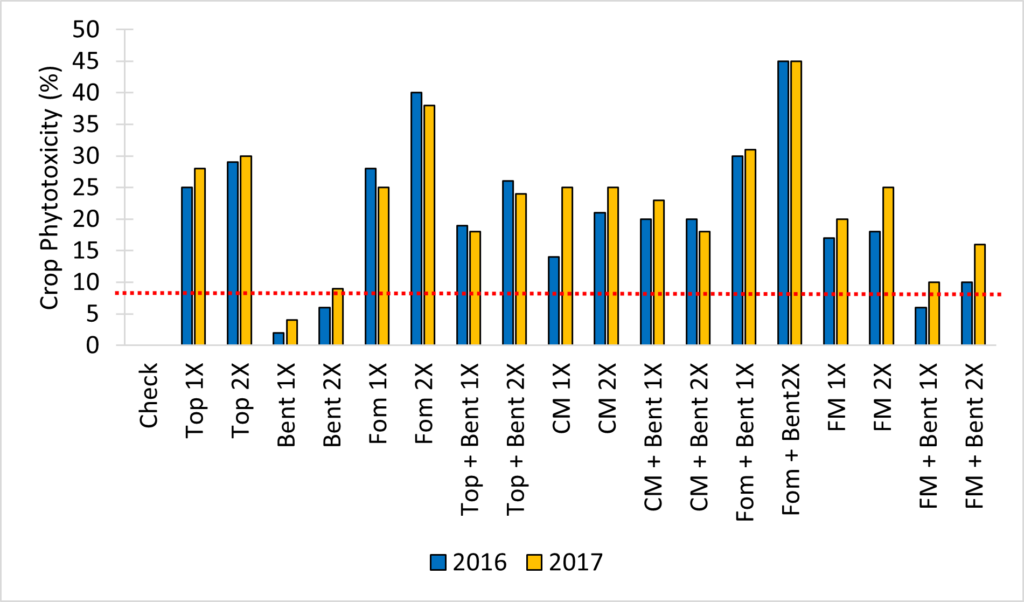
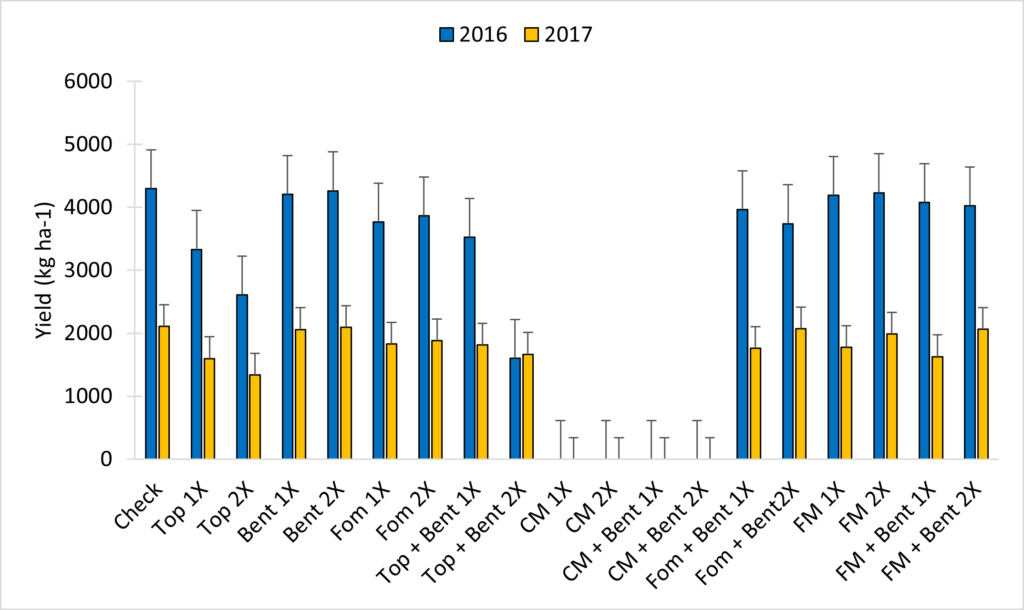
Tolerance of Faba Beans to Pre-Emergent and In-Crop Herbicide Combinations
A third herbicide tolerance study took place assessing a large set of pre- and post-emergent herbicide combinations across Scott, Melfort, and Kernen research farms in 2017 and 2018 for a total of five site- years. Six pre-emergent herbicide treatments, including pyroxasulfone (Zidua®), ethafluralin (Edge®), saflufenacil (Heat®), flumioxazin (Valtera™), pyroxasulfone and sulfentrazone (Authority® Supreme), and pyroxasulfone plus saflufenacil (Zidua® and Heat®), were applied on their own (PRE), as well as in combination with both imazamox/ bentazon (Viper®) and imazamox/imazethapyr/sethoxydim (Odyssey®) separately (PRE+POST) at registered rates. As well, Viper® and Odyssey® were each applied with no pre-emergent for a total of 20 treatments. Weed density, weed biomass, and crop yield were assessed.
In the weed density assessments prior to in-crop application, all pre- emergent herbicides reduced total broadleaf weed density by up to 70% compared to check. A reduction in early season weed density translates to lower in-crop herbicide resistance selection pressure.
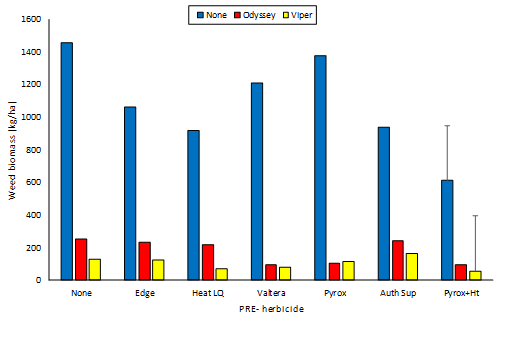
Final weed biomass was much higher for the PRE treatments than PRE+POST treatments (Figure 8). Yield was also lowest for pre- emergent only treatments (Figure 9), with only Zidua® plus Heat® having a significantly higher yield than the check. These results indicate that a post-emergent herbicide is necessary for season- long weed control. Weed biomass was not significantly lower for the PRE+POST treatments than the POST only treatments (Figure 8). As well, there was no significant difference in yield between PRE+POST and POST treatments. These results indicate that there was no added benefit regarding weed biomass or yield with the addition of a pre-emergent herbicide ahead of an in-crop herbicide application. While the addition of a pre-emergent herbicide along with an in-crop herbicide may not provide a yield benefit, herbicide layering is still recommended for reducing weed biomass prior to in-crop herbicide application and thus reducing resistance selection pressure.
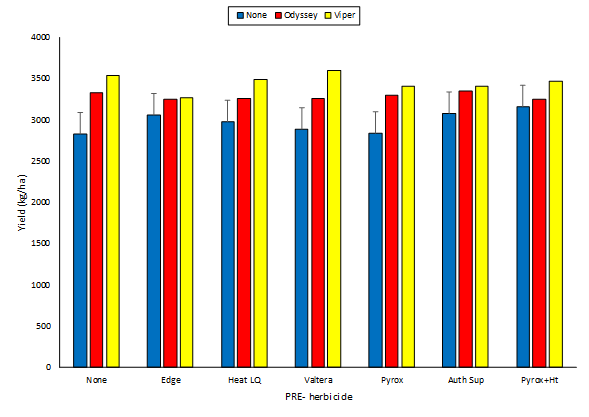
Pyridate Tolerance in Faba Beans
Pyridate is a group 6 herbicide that selectively controls broadleaf weeds including kochia, lambsquarters, redroot pigweed, and wild mustard. It is currently registered with the trade name Tough 600EC® through Belchim Crop Protection for pre-seed use in chickpeas, lentils, and peas, and post-emergent in chickpea. This study assessed tolerance of pyridate as an in-crop herbicide application in faba bean as well as flax, field pea, and chickpea at Kernen in 2019 and 2020. Pyridate was applied at 900 and 1800 g ai/ha in 2019, and at 300 and 600 g ai/ha in 2020. Pyridate was compared to Basagran and a hand- weeded untreated check.
Pyridate in-crop caused 20–40% visual crop injury to faba beans in 2019 and 10–19% in 2020. Faba yield loss compared to the check was 17–36% in 2019 but was 0% in 2020. Due to crop injury and yield loss, pyridate was not considered safe for in-crop use in faba beans.
Study Area 5: Faba bean desiccation
Harvest aid products registered on faba beans include diquat and glyphosate, however little is understood on the dry down efficacy of these chemistries. In addition, there are several other contact herbicides that could possibly be utilized as preharvest aids in faba beans, however, little to no research has been conducted on the efficacy, yield and quality impacts required for label expansion with these products. Possible, but untested, herbicides include saflufenacil and glufosinate. Also not understood is the response of low-tannin versus high-tannin varieties to application of preharvest products. The following studies aim to further develop best practices for faba bean desiccation.
Timing of Faba Bean Desiccation
Desiccation timing is an important factor for efficacy, dry down, and yield in most crops. This five site-year study carried out at Kernen and Scott between 2018 and 2020 combined three herbicide treatments (glyphosate, saflufenacil (Heat®), and glyphosate with Heat®) with five application timings based on seed moisture (60%, 50%, 40%, 30%, 20%). Glyphosate was applied at 1 L/ac of 360 concentration and Heat® was applied at 29 mL/ac alone (30 ac/cs), and at 59 mL/ ac (60 ac/cs) with glyphosate. Plant density, plant dry down at 7, 14, and 21 days after treatment (DAT), seed moisture, and yield were assessed. Herbicide residue in harvested crop material was not assessed in this research.
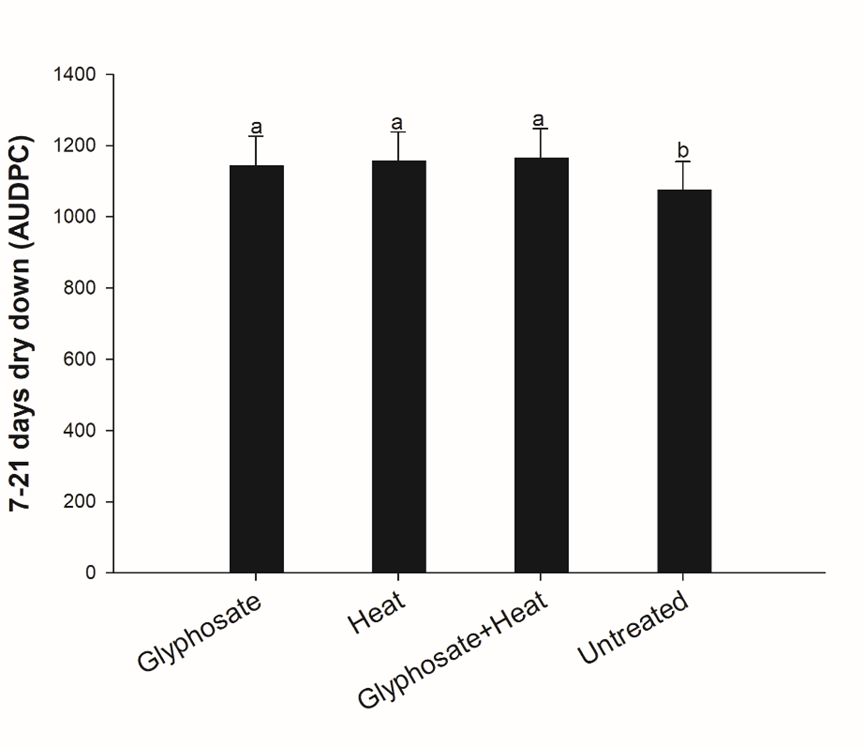
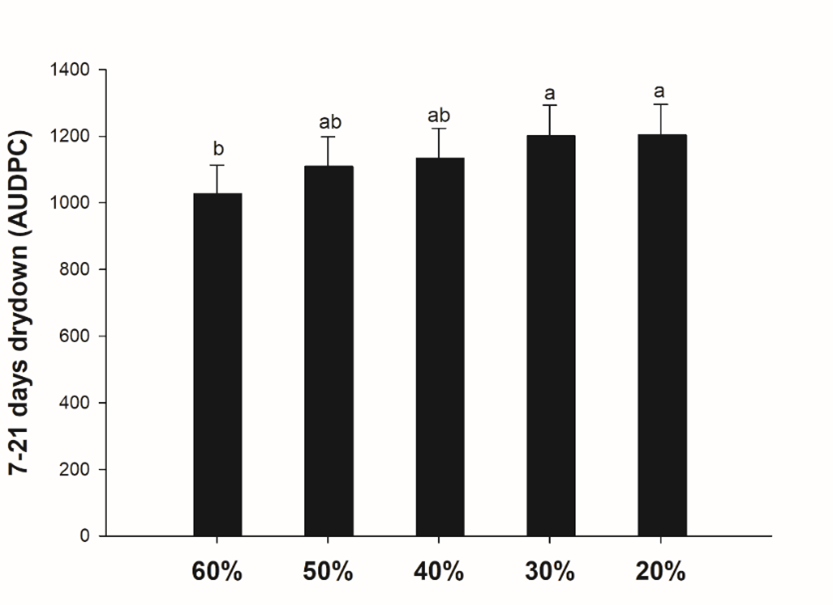
Herbicide significantly increased the dry down rate compared to the untreated check, with similar dry down rates between the three treatments (Figure 10). Desiccation timing also had a significant impact on dry down rate, with the 20% timing drying down 17% faster than the 60% treatment (Figure 11). There was no significant difference in dry down time between the 20–50% seed moisture desiccation timings. Green and black seed content was statistically impacted by herbicide timing, with the 20% timing significantly lower in green seed and higher in black seed than the 60% timing at each site-year. Quality results differed by site-year (Table 6). There was no significant difference in green seed content between the 20 and 30% timing at three of five site-years, and between the 20–50% desiccation timings in the remaining two site-years. There were no yield differences between any treatments.
Table 6. Mean green seed values at different desiccation timings at Kernen 2018-2019, Scott 2018-2021.
| Desiccation timing | Kernen | Scott | |||
| 2018 | 2019 | 2018 | 2019 | 2021 | |
| 20% | 0.12b* | 4.92b | 0.34c | 0.03d | 0.01b |
| 30% | 0.33bc | 8.25b | 0.10c | 0.00d | 0.01b |
| 40% | 0.55bc | 25.95a | 5.96b | 3.00c | 0.00b |
| 50% | 1.63bc | 33.07a | 8.23b | 41.20b | 0.01b |
| 60% | 14.56a | 38.95a | 14.22a | 79.83a | 5.75a |
*Different lower-case letters after mean green seed values within the same column represent statistically significant differences between values (p<0.05)
Heat®, glyphosate, or Heat® and glyphosate in combination provided similar results for dry down timing and crop quality. Desiccation product selection should be based on weed spectrum, for example selecting glyphosate for perennial weeds, and incorporating Heat® if kochia is the main weed issue. The best and safest application timing for faba beans, from a residue standpoint, is 20% moisture for fastest dry down and lowest green seed content. Seed moisture contents above 30% are off-label and did not significantly improve dry-drown or green seed content.
Varietal Differences in Faba Bean Dry-Down
Six faba bean varieties, three low-tannin (CDC Snowdrop, Snowbird, and Tabasco) and three tannin (CDC SSNS-1, Malik, and Taboar) received five different herbicide treatments (untreated, glyphosate at 1 L/ac of 360 concentration, Heat® at 29 mL/ac, diquat (Reglone®) at 0.5 L/ac rate (0.6L/ac Reglone® Ion), and glufosinate (Liberty®) at 1.08L/ac) for a total of 30 treatments. Along with tannin content, the faba cultivars also varied in maturity, with Malik, CDC Snowdrop, and Snowbird being early maturing (104 days), and CDC SSNS-1, Tabasco, and Taboar being late maturing (105–107 days). Research took place at Kernen Research Farm from 2016–2018. Timing for preharvest products was when bottom pods were black, approximately 30% seed moisture. Visual dry down, seed and straw moisture content, and yield were assessed.
There was no significant difference in yield or straw moisture content for any herbicide treatments compared to the non-desiccated check. Glyphosate and Heat® did not reduce dry down time in comparison to the untreated check for any faba varieties. As well, none of the desiccation products reduced dry down time in the early maturing cultivars. Liberty® and Reglone®, however, had a significantly reduced dry down time compared to the check in the late-maturing varieties, with 25–50% faster dry down time than the check with Tabasco and Taboar.
From this research, desiccation may not improve dry down time for early maturing faba bean varieties. A reason to use a desiccant with early maturing varieties would be for weed control to improve harvestability. When farmers are growing later maturing faba bean varieties, Reglone® would be a good choice for faster crop dry down. Note that Reglone® will dry down weeds but will not provide weed control. Although glufosinate produced favourable dry down results, further research is required to determine registration suitability as a preharvest aid in faba beans.
Key Findings and Management Recommendations
See below for a summary of the key findings from the research above, as well as the faba bean weed management recommendations developed from these research projects.
Weed Removal Timing
Key Findings
- Critical period of weed control (CPWC) for faba bean was 4-9 node (2-7 true leaf) with some variation by site-year.
- Layered use of pre- and post-emergent herbicides resulted in an increase in crop biomass and decrease in weed biomass, but no increase in yield.
- There was no significant yield or biomass difference between the 4 and 8 node (2 and 6 true leaf) in-crop herbicide application timing.
Recommendations
- Remove weeds in the 4-9 node (2-7 leaf) stage.
- Layer pre- and post-emergent herbicides to reduce early season weed competition and extend the herbicide application window.
IWM in Faba Bean
Key Findings
- The addition of Authority® Supreme to glyphosate as a pre- emergent herbicide application reduced weed biomass by 65–85% at two of four site-years. The further addition of Viper® in crop reduced weed biomass by another 85–98%, also at two of four site-years.
- Increasing seeding rate from 50 seeds/m2 to 125 seeds/m2 reduced weed seed production by 40% when glyphosate only was applied. Increased seeding rate did not decrease weed seed production in the PRE or PRE-POST treatments.
- Yields were highest with application of both Authority® Supreme and Viper®, with no significant difference between seeding rates. Yield increased with seeding rate in the glyphosate only treatment.
- Pre-emergent application of Heat® or Authority® Supreme resulted in a 70–90% reduction in weed biomass compared to glyphosate alone, slightly improved over Valtera™. All three pre-emergent herbicides reduced weed seed production similarly, by 50–70%.
- Weed biomass decreased by 70–90% and yield increased by 52–426% in the medium and high intensity IWM treatments compared to the low intensity treatment.
- Yield increase from the low to medium IWM level was greater than the yield increase from the medium to high IWM treatment at all site-years, with a 57–314% yield increase between the low and medium levels versus a -17% to +27% difference moving from the medium to high level.
Recommendations
- Application of a pre-emergent herbicide such as Authority® Supreme with glyphosate, followed by an in-crop herbicide such as Viper®, is recommended to maximize weed control and crop yield.
- Increase seeding rate above 50 seeds/m2 (approximately 5 plants/ft2) for improved weed competition and faba bean productivity. Increase seeding rate to 125 seeds/m2 (approximately 12.5 plants/ft2) if only using pre-emergent glyphosate.
- Seeding in the beginning of May and reducing row spacing from 60 to 30 cm along with pre-emergent application of soil residual herbicides is an effective IWM strategy. The additional cultural practices of increased seeding rate and rotary hoeing may further increase yield 50% of the time.
Herbicide Recropping
Key Findings
- Most residual herbicides assessed (Lontrel™, dicamba, Infinity®, Ally®, Everest®, and quinclorac) resulted in some form of crop injury depending on the site-year. Faba beans were most sensitive to clopyralid (Lontrel™) and quinclorac (Accord®, Facet L®), with a 50–75% yield loss in two of seven site-years at higher rates.
- Faba bean varieties did not differ in their tolerance to residue from Lontrel™, Accord®, Everest® or Ally®.
- Faba beans were more sensitive than field peas to group 4 carryover from clopyralid (Lontrel™) but showed similar low sensitivity to group 2 flucarbazone (Everest®) carryover.
Recommendations
- Avoid growing faba beans where clopyralid or quinclorac have been applied in the previous season.
- Do not expect differences in herbicide residue tolerance between different faba bean varieties.
- Expect faba beans to have greater sensitivity to Lontrel™ carryover than field peas.
- Expect faba beans to have similar sensitivity to Everest® carryover as field peas.
New Herbicide Screening
Key Findings
- Of the pre-emergent herbicides assessed, pyroxasulfone plus carfentrazone (Focus®) was the only treatment that resulted in a yield decline, which was 11–13% in 1 of 3 years.
- Fluthiacet-methyl and fomesafen applied in crop resulted in unacceptable phytotoxicity levels but did not reduce faba yield, however topramezone caused some crop injury and reduced crop yield especially at high rates. Cloransulam-methyl application resulted in crop death.
- Use of pre-emergent herbicides in conjunction with an in-crop herbicide reduced weed density prior to in-crop herbicide application but did not reduce final weed biomass or improve yield compared to an in-crop herbicide without a pre-emergent application.
- In crop pyridate application resulted in 10–40% visual crop injury and 0–36% yield loss.
Recommendations
- Focus® should not be used as a pre-emergent with faba beans.
- Cloransulam-methyl, fluthiacet-methyl, fomesafen, and topramezone are not safe for use in faba beans.
- Even if pre-emergent herbicides do not improve yield, their use is still recommended to reduce early season weed pressure and consequently reduce in-crop herbicide resistance selection pressure.
- Pyridate is not safe for in-crop use in faba beans.
Faba bean desiccation
Key Findings
- Use of a harvest aid product reduced dry down time compared to natural dry down, with similar dry down rates between Heat®, glyphosate, and Heat® plus glyphosate.
- Compared to the 60% seed moisture desiccation timing, desiccation at 20% seed moisture resulted in 17% faster dry down, as well as higher quality with significantly lower green seed content and higher black seed content. Quality results were similar for the 20 and 30% seed moisture timings at three of five site- years and similar between the 20–50% seed moisture timings at two of five site-years.
- Use of a harvest aid did not speed dry down of early maturing faba varieties when desiccant was applied at 30% seed moisture. As well, glyphosate and Heat® did not increase dry down time compared to the control.
- Reglone® and glufosinate (not registered for preharvest use) provided 25–50% faster dry down of later maturing varieties compared to the check.
Recommendations
- Use a desiccation product to decrease dry down time, with product selection based on the weed spectrum.
- Desiccate at lower seed moisture content (20–30%) for faster dry down time and improved quality. There may be no difference in quality by desiccating at 20–30% vs 40–50% moisture. Applications above 30% seed moisture are off label and are not recommended.
- Desiccation of early maturing faba bean varieties may not shorten dry down time in comparison to natural dry down. If weeds are present, however, desiccant use may dry down weeds and improve overall harvestability.
- For later maturing faba varieties only, Reglone® may have a reduced dry down time compared to Heat® or glyphosate. Glufosinate also had a reduced dry down time but is not registered for preharvest use in faba beans.
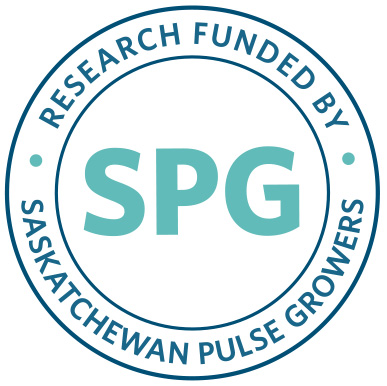
Enhancing weeds science in pulse crops: Towards a robust strategy for long-term weed management
Dr. Christian Willenborg University of Saskatchewan – Dept. of Plant Sciences Objective
